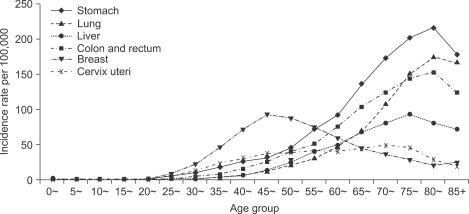Cancer Res Treat.
2007 Dec;39(4):139-149.
National Cancer Incidence for the Year 2002 in Korea
- Affiliations
-
- 1Korea Central Cancer Registry, National Cancer Center, Goyang, Korea. shinhr@iarc.fr
- 2International Agency for Research on Cancer, Lyon, France.
- 3Korean Medical Record Association, Seoul, Korea.
- 4National Health Insurance Corporation, Seoul, Korea.
- 5Cancer Control Policy Team, Bureau of Health Policy, Ministry of Health & Welfare, Gwacheon, Korea.
- 6Busan Cancer Registry, Busan, Korea.
- 7Daegu Cancer Registry, Daegu, Korea.
- 8Incheon Cancer Registry, Incheon, Korea.
- 9Daejeon Cancer Registry, Daejeon, Korea.
- 10Gwangju Cancer Registry, Gwangju, Korea.
- 11Ulsan Cancer Registry, Ulsan, Korea.
- 12Jeju-do Cancer Registry, Jeju, Korea.
Abstract
-
PURPOSE: Since the revised Cancer Act of October 2006, cancer registration was reactivated, based on the Statistics Law.
MATERIALS AND METHODS
The incidence of cancer during 2002 was calculated on the basis of the information available from the National Cancer Incidence Database. Crude and age-standardized rates were calculated by gender for 18 age groups (0~4, 5~9, 10~14, every five years, 85 years and over).
RESULTS
The overall crude incidence rates (CRs) were 269.2 and 212.8 per 100,000 for males and females, and the overall age-standardized incidence rates (ASRs) were 287.8 and 172.9 per 100,000, respectively. Among males, the five leading primary cancer sites were stomach (CR 62.4, ASR 65.7), lung (CR 45.4, ASR 51.0), liver (CR 43.2, ASR 43.7), colon and rectum (CR 30.7, ASR 32.7), and prostate (CR 8.0, ASR 9.6). Among females, the most common cancer sites were breast (CR 33.1, ASR 26.9), followed by stomach (CR 32.8, ASR 26.0), colon and rectum (CR 23.1, ASR 18.5), thyroid (CR 19.1, ASR 15.7), and uterine cervix (CR 18.2, ASR 14.7). In the 0~14 age group, leukemia was the most common cancer for both genders. For males, stomach cancer was the most common cancer in the 15~64 age-group, but lung cancer was more frequent in men 65 or older. For females, thyroid cancer among the 15~34 age-group, breast cancer among 35~64 age-group and stomach cancer in women 65 years or older were the most common forms of cancer for each age group. The quality indices for the percentage of deaths, by death certificate only, were 4.7% for males and 4.5% for females.
CONCLUSIONS
Since the National Cancer Incidence Database was started, the annual percent change of cancer cases increased by 4.8% (4.1% for males, 5.7% for females) during 1999~2002. This value reflects the increase in prostate cancer for males and breast and thyroid cancer in females during 2002. The timely reporting of improved quality of cancer registration is needed for evidence-based decisions regarding cancer control in Korea.
MeSH Terms
Figure
Reference
-
1. Parkin DM. The evolution of the population-based cancer registry. Nat Rev Cancer. 2006; 6:603–612. PMID: 16862191.
Article2. Shin HR, Jung KW, Won WJ, Park JG. 139 KCCR-affiliated hospitals. 2002 Annual Report of the Korea Central Cancer Registry: based on registered data from 139 hospitals. Cancer Res Treat. 2004; 36:103–114.3. National Statistical Office in Korea. Annual report on the cause of death statistics (based on vital registration). 2007. Daejeon: National Statistical Office in Korea.4. Shin HR, Won YJ, Jung KW, Kong HK, Yim SY, Lee J, et al. Nationwide cancer incidence in Korea, 1999-2001; first result using the National Cancer Incidence Database. Cancer Res Treat. 2005; 37:325–331.
Article5. National Statistical Office. Annual report on the cause of death statistics (based on vital registration). 2003.6. Ministry of Health and Welfare. Yearbook of health & welfare statistics. 2007. Korea:7. Korean Statistical Information Service. 2007. cited 2007/12/11. Available from: http://www.kosis.kr/.8. Ferlay J, Bray F, Pisani P, Parkin DM. GLOBOCAN 2002 Cancer Incidence, Mortality and Prevalence Worldwide. 2004. 2.0 ed. Lyon:9. Curado MP, Edwards B, Shin HR, Storm H, Ferlay J, Heanue M, editors. IARC Scientific Publications No. 160. Cancer incidence in five continents. 2007. Vol. IX. Lyon: IARC.10. Parkin DM. Comparability and quality control in cancer registration. 1994. International Agency for Research on Cancer.11. Seiffert J. North American Association of Central Cancer R, Registry Operations C. Standards for Completeness, Quality, Analysis, and Management of Data. 2000. North American Association of Central Cancer Registries.12. Cormier M. User guide to data quality reports for provincial/Territorial Cancer Registries. 2005.13. Jensen OM, Parkin DM, Maclennan R, Muir CS, Skeet RG, editors. Cancer Registration Principles and Methods. 1991. Lyon: IARC Scientific Publication.
- Full Text Links
- Actions
-
Cited
- CITED
-
- Close
- Share
- Similar articles
-
- Cancer Statistics in Korea: Incidence, Mortality, Survival, and Prevalence in 2015
- Cancer Statistics in Korea: Incidence, Mortality, Survival, and Prevalence in 2014
- Cancer Statistics in Korea: Incidence, Mortality, Survival, and Prevalence in 2012
- Cancer Statistics in Korea: Incidence, Mortality, Survival, and Prevalence in 2011
- Cancer Statistics in Korea: Incidence, Mortality, Survival, and Prevalence in 2013



